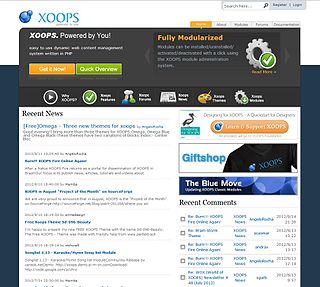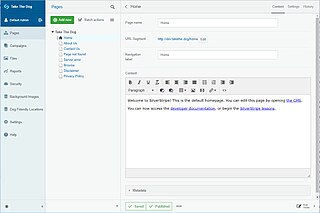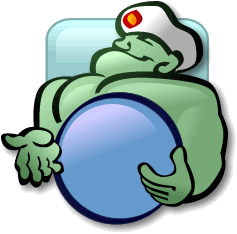
Drupal is a free and open-source web content management system (CMS) written in PHP and distributed under the GNU General Public License. Drupal provides an open-source back-end framework for at least 14% of the top 10,000 websites worldwide and 1.2% of the top 10 million websites—ranging from personal blogs to corporate, political, and government sites. Systems also use Drupal for knowledge management and for business collaboration.

Adobe ColdFusion is a commercial rapid web-application development computing platform created by J. J. Allaire in 1995. ColdFusion was originally designed to make it easier to connect simple HTML pages to a database. By version 2 (1996) it had become a full platform that included an IDE in addition to a full scripting language.

XOOPS is a free open-source content management system (CMS), written in PHP. It uses a modular architecture allowing users to customize, update and theme their websites. XOOPS is released under the terms of the GNU General Public License (GPL) and is free to use, modify and redistribute.
A web content management system is a software content management system (CMS) specifically for web content. It provides website authoring, collaboration, and administration tools that help users with little knowledge of web programming languages or markup languages create and manage website content. A WCMS provides the foundation for collaboration, providing users the ability to manage documents and output for multiple author editing and participation. Most systems use a content repository or a database to store page content, metadata, and other information assets the system needs.
CherryPy is an object-oriented web application framework using the Python programming language. It is designed for rapid development of web applications by wrapping the HTTP protocol but stays at a low level and does not offer much more than what is defined in RFC 7231.
A web framework (WF) or web application framework (WAF) is a software framework that is designed to support the development of web applications including web services, web resources, and web APIs. Web frameworks provide a standard way to build and deploy web applications on the World Wide Web. Web frameworks aim to automate the overhead associated with common activities performed in web development. For example, many web frameworks provide libraries for database access, templating frameworks, and session management, and they often promote code reuse. Although they often target development of dynamic web sites, they are also applicable to static websites.

Catalyst is an open source web application framework written in Perl, that closely follows the model–view–controller (MVC) architecture, and supports a number of experimental web patterns. It is written using Moose, a modern object system for Perl. Its design is heavily inspired by frameworks such as Ruby on Rails, Maypole, and Spring.
Open Power Template is a web template engine written in PHP 5. A common strategy in designing web application is separation of the application logic from the presentation. OPT is a tool for implementing such separation. The presentation layer is represented by templates, text files with HTML code and extra instructions controlling the data substitution.

A web template system in web publishing allows web designers and developers work with web templates to automatically generate custom web pages, such as the results from a search. This reuses static web page elements while defining dynamic elements based on web request parameters. Web templates support static content, providing basic structure and appearance. Developers can implement templates from content management systems, web application frameworks, and HTML editors.

Silverstripe CMS is a free and open source content management system (CMS) and framework for creating and maintaining websites and web applications. It provides an out of the box web-based administration panel that enables users to make modifications to parts of the website, which includes a WYSIWYG website editor. The core of the software is Silverstripe Framework, a PHP Web application framework.

Big Medium was a browser-based web content management system (CMS) written in the Perl programming language and developed by Global Moxie, the Paris-based company of independent developer Josh Clark.
Flow is a free and open source web application framework written in PHP. The first final version was released on October 20, 2011. It was primarily designed as a basis for the content management system Neos, but can also be used independently. It is generally suitable for PHP development of mid- or large-scaled web applications.
Web2py is an open-source web application framework written in the Python programming language. Web2py allows web developers to program dynamic web content using Python. Web2py is designed to help reduce tedious web development tasks, such as developing web forms from scratch, although a web developer may build a form from scratch if required.

CMS Made Simple (CMSMS) is a free, open source (GPL) content management system (CMS) to provide developers, programmers and site owners a web-based development and administration area. In 2017 it won the CMS Critic annual award for Best Open Source Content Management.
Content migration is the process of moving information stored on a given computer information system (IS) to a new system. The IS may be a Web content management system (CMS), a digital asset management (DAM), or a document management system (DMS). The IS may also be based on flat HTML content, including HTML files, Active Server Pages (ASP), JavaServer Pages (JSP), PHP, or content stored in some type of HTML/JavaScript based system and can be either static or dynamic content.
Kajona is a PHP based content management framework, released and developed as an open source project using the GNU Lesser General Public License. The system requires a relational database system such as MySQL, PostgreSQL or SQLite. Due to the abstraction of the database provided by Kajona's database-layer, nearly all relational database systems can be connected. Kajona uses UTF-8 to store its content, resulting in a system suitable for international websites. Since the system is written as a framework, external developers are able to enrich the system with new functionalities using one of the many hooks / plugin concepts Kajona provides. There are HotSpots for nearly every aspect such as for widgets, search plugins, elements or modules.
Omni CMS (formerly OU Campus) is a web content management system (CMS) for colleges, universities, and other higher education institutions.
Magnolia is an open-source content management system (CMS). It is developed by Magnolia International Ltd., based in Basel, Switzerland. It is based on Content repository API for Java (JSR-283).
ASP.NET Web Forms is a web application framework and one of several programming models supported by the Microsoft ASP.NET technology. Web Forms applications can be written in any programming language which supports the Common Language Runtime, such as C# or Visual Basic. The main building blocks of Web Forms pages are server controls, which are reusable components responsible for rendering HTML markup and responding to events. A technique called view state is used to persist the state of server controls between normally stateless HTTP requests.







